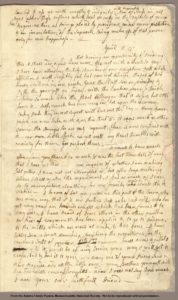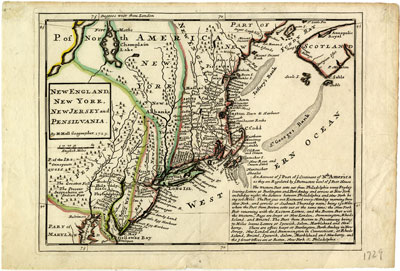“She wrote me a letter and she wrote it so kind
She put down in writing what was in her mind.”
Bob Dylan, “Not Dark Yet”
Abigail Adams often complained that her husband, John, did not write her enough. When he did write, his letters were too short and didn’t adequately convey his sentiments. “I have to acknowledg the Recept of a very few lines dated the 12 of April,” Abigail reported to John in 1776, but “you make no mention of the whole sheets I have wrote to you,” she chided him. This complaint resonated with my students in Gender in Early American History. A few of my students designed a meme to capture Abigail’s protest. The meme depicted a skeleton with folded arms sitting at a desk. It was captioned: “Me waiting for your letters.” One simple image and a few words translated Abigail’s words into a contemporary media form. I had not even asked students to design memes. I had only asked them to compose a series of Facebook posts or tweets for an assignment in which they “translated” eighteenth-century correspondence into contemporary social media. Far ahead of me on social media trends, my students surpassed my instructions and expectations. Their enthusiasm illustrated to me the possibilities of engaging them in the world of eighteenth-century letters through their own use of social media.
Literary critics and historians such as Konstantin Dierks, Eve Tavor Bannet, and Lindsay O’Neill have recently expanded our understanding of the letter-writing practices and correspondence networks that connected people in eighteenth-century America and the Atlantic world. Letters enabled them not only to communicate with each other across great distances, but also to build relationships, develop associations and movements, and advance themselves socially, politically, and economically. During the eighteenth century, letter-writing manuals circulated widely on both sides of the Atlantic. Middle-class men and women turned to these manuals to learn the proper conventions of correspondence. The epistolary form shaped other media too. Pamphlets sometimes took the form of letters, and newspapers frequently published letters to the editor. Early novels such Samuel Richardson’s Clarissa, or, The History of a Young Lady appeared as series of fictive letters that revealed the complexities of the characters’ (especially women’s) inner lives.
Letters were even made public sometimes. For instance, Benjamin Franklin intercepted the correspondence of the royal governor of Massachusetts, Thomas Hutchinson, and leaked it to the press. The published correspondence mobilized the colonial opposition to Crown officials. Indeed, letters made revolutions. In the years before 1776, the Committees of Correspondence organized inter-colonial resistance to British imperial authority. British Corresponding Societies, United Irishmen, French Jacobin clubs, and American Democratic-Republican Societies expanded this practice of revolutionary correspondence to the rest of the Atlantic world in the 1790s. Letters mattered in the eighteenth century in the same way that the explosion of new media forms such as Facebook, Twitter, Snapchat, memes, gifs, and Instagram have reshaped communication and politics in our own time—yet twenty-first-century students sometimes struggle to relate to the old-fashioned medium of letters.
Consequently, I have used these new media forms to teach about old media in an upper division course for the past three years, each time revising and expanding the activity because of its popularity with students. Students form groups of three to five members, and I assign a different set of six to ten letters for each group to read before class. Students spend two class periods working on the “translation,” writing a minimum of twenty social media posts based on that correspondence. They also usually collaborate outside of class to finalize their posts. Each group then presents its work to the rest of the class. During these discussions, students’ newfound enthusiasm for eighteenth-century letters is often palpable. In the process, students sharpen their reading and writing skills and their understanding of how correspondence works.
The correspondence of John and Abigail Adams—one of the most famous in early America—encompasses over 1,000 letters written between 1762 and 1801. Of course, John and Abigail wrote to each other only when they were apart, but they were frequently separated during their fifty-four years of marriage. Their correspondence began during their courtship, and included letters written when John was being inoculated against smallpox and was so contagious that he could not meet with Abigail. After their marriage, they were often separated when John worked as a lawyer in the Massachusetts county court circuit, as a delegate to the Continental Congress in Philadelphia, as a diplomat in Europe during the Revolutionary War, and as vice president and then president during the 1790s. John and Abigail’s correspondence continued the conversation of their marriage throughout those years of absence.
Their letters are widely accessible in several edited compilations, in the documentary edition of The Papers of John Adams, and in The Adams Family Papers: An Electronic Archive, a digital archive of the Massachusetts Historical Society. Searchable both by keyword and by date, this archive offers links to digital images of the original letters and transcriptions. When I selected letters for this assignment, I highlighted the conversational nature of the correspondence by choosing examples from the Revolutionary War in which John and Abigail were responding to each other’s comments and queries. The digital archive made this easy to do since the transcribed letters feature convenient hyperlinks to the other letters mentioned in the correspondence.
In class, I lectured briefly on the historical context of eighteenth-century letters and on John and Abigail’s relationship, then advised students to begin the assignment by brainstorming in their small groups the issues, events, and topics that John and Abigail discussed in their correspondence and pinpointing which sentiments would make good social media posts. They immediately observed that the correspondence addressed a wide variety of topics, jumbled and sometimes incongruent. A single letter might refer to political news as well as medical issues, family concerns, and neighborhood gossip, a diversity, they noted, that parallels the range of topics that appear in people’s social media feeds today.
Students imitated John and Abigail’s flow of ideas, composing posts that reflected this mix of subjects, personal and political. For example, students learned about how Abigail struggled with a smallpox pandemic in Boston, while John argued for Independence in the Continental Congress in Philadelphia. The current controversies over vaccination made many students especially curious about the letters in which Abigail discussed her decision to inoculate herself and her three children against smallpox, a decision that was simultaneously personal, familial, and political. “Hope the necessity [of inoculation] is now fully seen,” Abigail commented in July 1776. Accordingly, a group of students had Abigail tweet: “Got the kids inoculated,” adding in pro-vaccination hashtags like #vaccinateyourkids and #vaxwithme to reflect Abigail’s endorsement.
Meanwhile, John wrote to Abigail on July 3, 1776: “Yesterday the greatest Question was decided, which ever was debated in America, and a greater perhaps, never was or will be decided among Men. A Resolution was passed without one dissenting Colony.” Students had John Adams post this news as:
“So excited about the things getting done here with congress. Great choices being made that even Delaware and South Carolina agreed on #freeandindependentstates #spoilers #declaration.”
Yet, students recognized that John’s letters did not solely discuss politics. They created posts based on quotidian matters too. “Yesterday I dined with Captain Richards,” John wrote to Abigail on June 2, 1776, “We had Cherries, Strawberries, and Green Peas in Plenty.” Students noted that John’s remarks on food would have been worthy of sharing on Instagram, where users frequently post photographs of their meals and they added #somuchpeasandberries to their post.
This intermingling of the personal and the political humanized John and Abigail Adams for my students. “These historical figures,” one student remarked, “can be made out to be larger than life,” but the social media assignment made them more “relatable for students today.” In learning that the Revolutionary War did not stop John and Abigail from worrying about their children’s education and health or relishing what they ate for dinner, students saw the overlap between political and social histories.
They also began to understand the American Revolution not just as a fight over abstract concepts such as “taxation without representation,” but as a lived experience. In her letter of March 2, 1776, Abigail confessed that “I have been kept in a continual state of anxiety and expectation ever since you left me.” Written during the Siege of Boston, the letter related the terrifying sound of the cannon fire, which interrupted Abigail’s writing several times: “but hark! the House this instant shakes with the roar of Cannon,” she wrote. Students dramatized this letter as a tweet:
Cannon fire is preventing any worthwhile sleep. #NoSleep #The Struggle Continues
Like the letter, the post conveyed Abigail’s fears and anxieties in wartime and the uncertainties that the Adams family faced during the Revolution. “We live, my dear Soul, in an Age of Tryal,” John wrote to Abigail on May 12, 1774. “What will be the Consequence I know not.” Translating these letters into social media familiar to their own generation turned out to be an excellent way to make students understand the uncertainty and contingency of the slowly unfolding struggle for American independence.
At the same time, “translating” the correspondence made students probe John and Abigail’s personalities and the dynamics of their relationship. Generally, students agreed that John would have embraced Twitter as a means of broadcasting his political opinions to the public, while his personal communications on Facebook would have been more limited. One student remarked that Abigail would have posted and commented on her husband’s page, while John’s interactions on his wife’s page would have been fewer and less emotional. On April 14, 1776, John wrote to Abigail: “You justly complain of my short Letters, but the critical State of Things and the Multiplicity of Avocations must plead my Excuse,” which students translated into this post: “My dear Abby complains too much of my letter writings. There IS a war going on you know.”
Nonetheless, many students sympathized with Abigail’s frustrations. “I want to hear much oftener from you than I do,” Abigail wrote to John on April 5, 1776, adding “You inquire of whether I am making Salt peter. I have not yet attempted it, but after Soap making believe I shall make the experiment.” One group imaginatively translated this line into Abigail telling John: “I want to hear more from you and all you can ask me is if I am making Salt peter?” They added #men to the post, putting a modern spin on the correspondence. Drawing on another letter of Abigail’s from August 14, 1776, one group had Abigail tweet:
“If we mean to have Heroes, Statesmen and Philosophers, we should have learned women.” #micdrop #protofeminist.
Though the tweet derived from Abigail’s letter, the hashtags added a contemporary touch. Interpreting eighteenth-century letters requires close reading, a task with which some students struggled. One student admitted that “understanding Revolutionary Era speech was the most challenging part [of the assignment],” but her group read through the sources multiple times, trying “to break down their correspondence into 140 characters or less.” Another student added that the activity was useful because they “had to translate the meaning of [the] letters into the terminology of how we speak today,” which enhanced their comprehension of the primary sources. Distilling eighteenth-century letters into their own language helped students to build their reading and analytical skills. As I listened to the conversations among the students, I overheard students asking each other questions about the meaning of words, the historical context of events mentioned in the letters, and the motivations of their authors. Grappling with the meaning of these sources, my students were doing history.
Their intensive and intuitive reading of the correspondence generated new insights into the history of everyday life during the American Revolution. The students got to know John and Abigail through their letters: Abigail’s pragmatic efficiency in running her household during wartime and her occasional sauciness; John’s vanity, his brusque and impolitic manner, and his exasperation when other people, including Abigail, did not see the world the way he saw it. The correspondence opened up for my students the intimate and emotional dimensions of history that are too often lost in the imposing political and military narratives of the American Revolution that we teach to students.
Translating John and Abigail’s correspondence into contemporary social media posts further prompted students to look outward and consider the continuities and discontinuities between past and present social media. The assignment helped them reflect on their own social media use. In a time of rapidly changing communication technologies, my students connected with an older media form. They found common ground with John and Abigail Adams, as students recognized their own struggles to communicate with loved ones in the correspondence of that extraordinary eighteenth-century couple. Perhaps a sign of the assignment’s success was that a student wrote a thank-you letter to me at the end of the semester. The letter was written on a sheet of paper, folded into an envelope, and delivered to my departmental mailbox.
Further Reading
On correspondence, see Konstantin Dierks, In My Power: Letter Writing and Communications in Early America (Philadelphia, 2009); Lindsay O’Neill, The Opened Letter: Networking in the Early Modern British World (Philadelphia, 2015); and Eve Tavor Bannet, Empire of Letters: Letter Manuals and Transatlantic Correspondence, 1680-1820 (Cambridge, 2005). Russ Castronovo has made some insightful comparisons between old and new media in Propaganda 1776: Secrets, Leaks, and Revolutionary Communications in Early America (Oxford 2014).
The biographical literature on John and Abigail Adams is extensive. See especially Woody Holton, Abigail Adams (New York, 2010) and Edith B. Gelles, Abigail and John: Portrait of a Marriage (New York, 2009), and Gelles, Abigail Adams: A Writing Life (New York, 2002).
Frank Shuffleton edited a volume of their Revolutionary War correspondence: The Letters of John and Abigail Adams (New York, 2004), while Gelles edited a volume of Abigail’s correspondence: Abigail Adams: Letters (New York, 2016). The Adams Family Papers: An Electronic Archive, organized by the Massachusetts Historical Society, is an invaluable resource for research and teaching. All quotations in this article are from that electronic archive.
This article originally appeared in issue 18.1 (Winter, 2018).
Michelle Orihel is associate professor of history at Southern Utah University. Her research focuses on politics and the print media in early American and Atlantic history. She is writing a book about the Democratic-Republican Societies and opposition politics in the trans-Appalachian West during the 1790s. She has published articles in The Historian, The New England Quarterly, and The Register of the Kentucky Historical Society. Her essay on pamphlets in early America is forthcoming in United States Popular Print Culture to 1860, the fifth volume in The Oxford History of Popular Print Culture, published by Oxford University Press.























